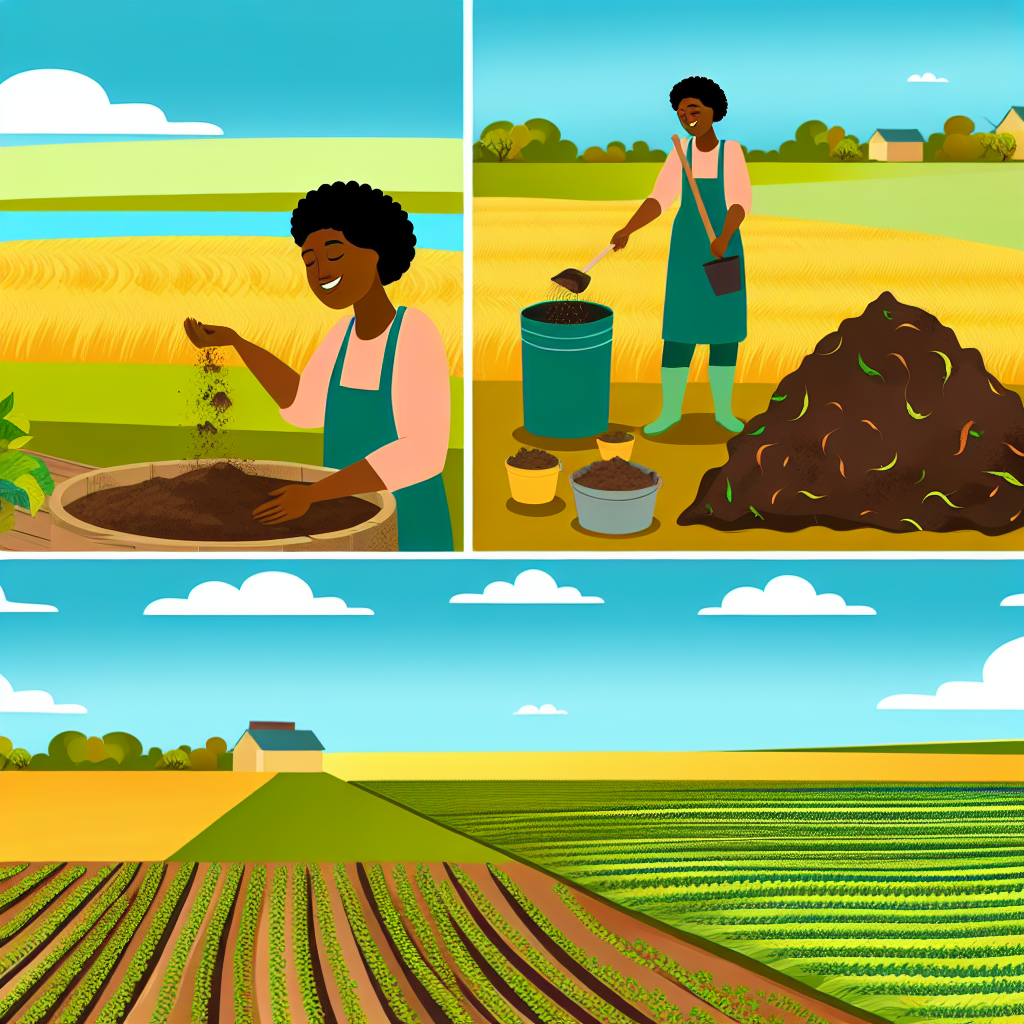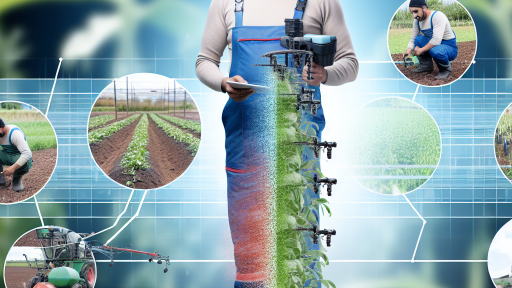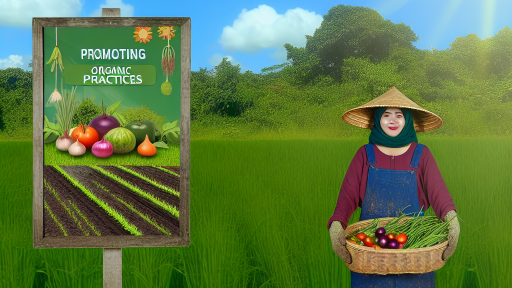Introduction to Soil Health
Definition of Soil Health
Ssoil health refers to the condition of soil in supporting plant growth.
It encompasses physical, chemical, and biological properties.
Healthy soil promotes crop yields, resilience, and sustainability.
Importance of Soil Health
Ssoil health is vital for agricultural productivity.
It impacts food security for a growing population.
Healthy soil contributes to nutrient delivery to plants.
Moreover, it plays a crucial role in water retention.
This also helps mitigate climate changes effects.
Components of Soil Health
Key components include soil structure, texture, and microbial activity.
A balanced pH level is also essential for nutrient availability.
Organic matter enrichment supports healthy microbial ecosystems.
These elements work together to create fertile ground.
Challenges to Soil Health
Many factors threaten soil health today.
Overuse of chemicals can degrade soil quality.
Soil erosion reduces its capacity to retain nutrients.
Transform Your Agribusiness
Unlock your farm's potential with expert advice tailored to your needs. Get actionable steps that drive real results.
Get StartedAdditionally, climate change poses significant risks.
Understanding Soil Composition: Minerals, Organic Matter, and Microorganisms
Composition of Soil
Soil is a complex system composed of minerals, organic matter, and life forms.
Each component plays a vital role in supporting plant growth and ecosystem health.
Minerals in Soil
Minerals are the building blocks of soil.
Rock particles break down over time, creating a variety of minerals.
Common minerals include quartz, feldspar, and clay.
They provide essential nutrients like potassium, calcium, and magnesium.
Moreover, mineral types affect soil texture and drainage capabilities.
Organic Matter: The Lifeblood of Soil
Organic matter is crucial for soil health and fertility.
It consists of decomposed plant and animal material.
Additionally, organic matter improves soil structure and moisture retention.
It also acts as a food source for beneficial microorganisms.
A rich organic layer fosters a diverse soil ecosystem.
Microorganisms: The Unsung Heroes
Microorganisms play an essential role in soil health.
They decompose organic matter, releasing nutrients into the soil.
Moreover, they enhance soil structure and aeration.
Common soil microorganisms include bacteria, fungi, and nematodes.
These organisms interact symbiotically with plant roots, promoting growth.
The Interaction of Components
The interaction between minerals, organic matter, and microorganisms is synergistic.
Together, they create a robust environment for crops to thrive.
Healthy soil supports a network of life that sustains ecosystems.
Consequently, understanding these components is vital for effective crop management.
Techniques to Improve Soil Structure for Better Crop Growth
Understanding Soil Structure
Soi structure significantly impacts crop growth and health.
It refers to the arrangement of soil particles and the spaces between them.
Showcase Your Farming Business
Publish your professional farming services profile on our blog for a one-time fee of $200 and reach a dedicated audience of farmers and agribusiness owners.
Publish Your ProfileWell-structured soil facilitates air and water movement.
This promotes healthy root systems and microbial activity.
Benefits of Improving Soil Structure
Improved soil structure enhances water retention and drainage.
It reduces soil compaction, allowing roots to penetrate easily.
Plus, it fosters a diverse ecosystem in the soil.
Healthy soil structure leads to higher crop yields.
Techniques to Enhance Soil Structure
- Cover Cropping
- Reduced Tillage
- Adding Organic Matter
- Crop Rotation
- Mulching
Planting cover crops adds organic matter to the soil.
These crops reduce erosion while improving soil aeration.
Minimizing tillage preserves soil structure and health.
It maintains essential microorganisms in the soil.
Incorporating compost or aged manure enriches soil structure.
Organic matter promotes aggregation of soil particles.
Crop rotation reduces pest pressure and soil depletion.
Different crops enhance soil nutrients in unique ways.
Adding mulch protects soil from erosion and temperature extremes.
It conserves moisture and suppresses weed growth.
Monitoring Soil Health
Regular soil testing provides essential insights.
This helps determine nutrient levels and pH balance.
Adjustments can then be made to improve soil structure.
Furthermore, observing plant health indicators is crucial.
Utilizing Technology
Modern technology can enhance soil structure management.
Soil sensors provide real-time data on moisture levels.
This helps in making informed irrigation decisions.
Additionally, drones can survey soil conditions from above.
Uncover the Details: Unlocking the Secrets of Crop Rotation for Year-Round Yield
The Role of Cover Crops in Enhancing Soil Fertility
Introduction to Cover Crops
Cover crops are plants grown primarily to benefit the soil.
They provide various advantages without seeking to harvest a crop.
Farmers often incorporate them into their crop rotation systems.
Improving Soil Structure
One key benefit of cover crops is improved soil structure.
Their root systems help break up compacted soils.
This creates channels for air and water movement.
As a result, soil becomes less prone to erosion.
Enhancing Soil Fertility
Cover crops enhance soil fertility through nitrogen fixation.
Leguminous cover crops, such as clover and vetch, excel in this area.
They capture atmospheric nitrogen and convert it into a usable form.
Consequently, their decay enriches the soil for subsequent crops.
Weed Suppression
Planting cover crops also contributes to weed suppression.
Their dense foliage outcompetes weeds for sunlight and nutrients.
As a result, fewer resources are available for weed growth.
This significantly reduces the need for herbicides.
Showcase Your Farming Business
Publish your professional farming services profile on our blog for a one-time fee of $200 and reach a dedicated audience of farmers and agribusiness owners.
Publish Your ProfileSoil Moisture Retention
Cover crops play an essential role in moisture retention.
They reduce evaporation by providing shade to the soil surface.
This helps maintain adequate moisture levels for crops.
Types of Cover Crops
- Legumes: Clover, vetch, and peas.
- Non-legumes: Rye, oats, and barley.
- Brassicas: Radishes and mustards.
Integrating Cover Crops into Your Farming System
Integrating cover crops requires planning and management.
Farmers should consider choosing appropriate species for their region.
Timing is crucial for planting and terminating cover crops.
With careful management, cover crops enhance overall farm productivity.
Discover More: Maximizing Crop Health: Why Micronutrients Matter More Than Ever
Composting: A Natural Way to Enrich Soil Nutrients
What is Composting?
Composting is the process of recycling organic material.
This includes kitchen scraps and garden waste.
Through decomposition, beneficial microorganisms break down materials.
The result is nutrient-rich compost that enhances soil health.
Benefits of Composting
Composting offers several advantages for farmers and gardeners.
First, it improves soil structure and fertility.
Additionally, it enhances water retention in the soil.
This can lead to healthier and more robust crops.
Moreover, composting reduces the need for chemical fertilizers.
Improves Soil Structure
Compost helps create a crumbly soil texture.
This structure promotes aeration and root growth.
Healthy soil supports better drainage and reduces erosion.
Enhances Water Retention
Soil enriched with compost retains moisture effectively.
This reduces the frequency of irrigation needed.
Consequently, crops are less stressed during dry periods.
Reduces Chemical Fertilizer Use
Compost provides essential nutrients naturally.
These nutrients are slowly released into the soil.
As a result, farmers can reduce reliance on synthetic fertilizers.
How to Start Composting
Starting a composting system is simple and rewarding.
Begin by choosing a suitable composting location.
A backyard or a dedicated bin works well for beginners.
Next, gather materials for your compost pile.
What to Compost
- Green materials: fruit scraps, vegetable peels, and grass clippings.
- Brown materials: dried leaves, cardboard, and paper.
A good balance of these materials accelerates composting.
Maintaining Your Compost
Turn the compost pile regularly to ensure aeration.
This speeds up the decomposition process.
Keep the pile damp but not soaked for optimal results.
Common Misconceptions
Many people believe composting is complicated.
In reality, it requires minimal effort and attention.
Additionally, some think composting smells bad.
When done correctly, it produces little to no unpleasant odors.
Start Composting for a Healthier Garden
Composting is an effective way to enrich your soil naturally.
It promotes sustainable farming practices and healthy crops.
Showcase Your Farming Business
Publish your professional farming services profile on our blog for a one-time fee of $200 and reach a dedicated audience of farmers and agribusiness owners.
Publish Your ProfileBy incorporating composting into your routine, you make a positive impact.
Start your composting journey today and enjoy its numerous benefits.
Discover More: The 7 Best Practices for High-Yield Corn Cultivation

Reducing Soil Erosion: Strategies for Sustainable Farming
Understanding Soil Erosion
Ssoil erosion is a significant threat to agricultural productivity.
It occurs when soil particles are displaced by wind, water, or human activity.
This loss of soil can lead to diminished crop yields over time.
Implementing Cover Crops
Cover crops are an effective way to combat soil erosion.
These plants protect the soil from harsh weather conditions.
Additionally, they enhance soil structure and fertility.
Farmers can choose legumes, grasses, or brassicas for this purpose.
Practicing Crop Rotation
Crop rotation prevents soil depletion and erosion.
This method involves alternating the types of crops grown in a field.
As a result, it maintains soil nutrients and promotes biodiversity.
Farmers should plan rotations based on crop families and growing seasons.
Applying No-Till Farming
No-till farming helps reduce soil disturbance significantly.
This practice preserves soil structure and moisture content.
Moreover, it leads to increased organic matter in the soil.
Farmers often find it a sustainable alternative to conventional farming.
Utilizing Terracing Techniques
Terracing is a highly effective method for hilly terrains.
This technique creates flat areas that slow water runoff.
By reducing runoff, it minimizes soil erosion significantly.
Farmers can increase their arable land while protecting the soil.
Incorporating Mulching
Mulching offers several benefits for soil health and erosion control.
This practice involves covering the soil with organic or inorganic materials.
It prevents erosion by reducing surface runoff and protecting the soil.
Moreover, mulching retains moisture and suppresses weed growth.
Engaging in Community Efforts
Community initiatives can amplify soil conservation efforts.
Farmers can share knowledge and resources through local groups.
Collaborative projects promote sustainable practices in the community.
Furthermore, community programs often provide funding for erosion control projects.
Seeking Expert Guidance
Consulting with soil experts is crucial for successful erosion management.
Experts can assess soil health and recommend specific strategies.
They encourage the implementation of adaptive practices based on local conditions.
Utilizing expert advice leads to better long-term outcomes for farmers.
Learn More: Secrets to Perfect Crop Cultivation for High Yields
The Impact of Crop Rotation on Soil Health and Pest Management
Enhancing Soil Fertility
Crop rotation significantly enhances soil fertility.
This method involves alternating different crops in the same area across seasons.
Such diversity helps replenish soil nutrients depleted by specific plants.
Legumes, for instance, fix nitrogen in the soil, enriching it for subsequent crops.
This strategy ultimately leads to higher crop yields over time.
Showcase Your Farming Business
Publish your professional farming services profile on our blog for a one-time fee of $200 and reach a dedicated audience of farmers and agribusiness owners.
Publish Your ProfileReducing Soil Erosion
Crop rotation can effectively reduce soil erosion.
Different root structures provide better soil coverage and prevent runoff.
Deep-rooted plants stabilize the soil better than shallow-rooted ones.
Thus, rotating crops improves overall soil structure and health.
Pest Management Benefits
Crop rotation also plays a crucial role in pest management.
It disrupts the life cycles of pests that thrive on specific crops.
This practice reduces the reliance on chemical pesticides.
Farmers can achieve healthier crops and ecosystems through this method.
Increased Crop Resilience
Using crop rotation significantly increases crop resilience.
Diverse cropping systems can withstand stress from pests and diseases.
This advantageous practice fosters a more balanced ecosystem.
Farmers benefit from reduced economic losses and improved yields.
Implementing Effective Crop Rotation Plans
For successful implementation, farmers should create a detailed crop rotation plan.
They must consider factors such as crop types, climate, and soil conditions.
A well-structured rotation plan ensures maximum benefits over time.
Regularly evaluating and adjusting the plan based on seasonal changes is essential.
Utilizing Green Manures for Soil Improvement and Enhancement of Biodiversity
What are Green Manures?
Green manures are cover crops grown primarily to improve soil health.
Farmers plant them to enhance soil fertility and structure.
They provide organic matter to the soil, enriching it over time.
The Benefits of Green Manures
Using green manures offers numerous advantages for farming.
- They improve soil structure by increasing aggregate stability.
- Green manures enhance soil fertility through nitrogen fixation.
- They suppress weeds, reducing the need for herbicides.
- These crops help prevent soil erosion, protecting topsoil.
- Green manures promote microbial activity, fostering biodiversity.
Types of Green Manures
A variety of plants can serve as effective green manures.
- Legumes like clover, vetch, and alfalfa are popular choices.
- Cereal grains such as rye and oats are also beneficial.
- Brassicas, including mustard, improve soil health and suppress pests.
How to Incorporate Green Manures into Farming
Farmers can effectively integrate green manures into their crop rotations.
First, choose a cover crop that suits the local climate and soil conditions.
Next, plant the green manure crop during the off-season of main cash crops.
Finally, incorporate the green manures into the soil before planting the next crop.
Enhancing Biodiversity with Green Manures
Green manures play a significant role in enhancing biodiversity in agro-ecosystems.
They provide habitats for beneficial insects and worms.
This helps to support pollinator populations and natural pest control.
Moreover, diverse root systems improve nutrient uptake and soil resilience.
Case Studies of Successful Green Manure Use
Many farmers have successfully adopted green manures to boost crop yields.
For instance, Emma Johnson on her organic farm has seen improved soil health.
Her yields increased significantly with the implementation of clover cover crops.
Similarly, Bob Martinez, a sustainable farmer, noted enhanced biodiversity in his fields.
Getting Started with Green Manures
Starting with green manures requires careful planning and consideration.
Conduct a soil test to determine nutrient needs and potential improvements.
Choose suitable green manure species based on your crop rotation plan.
Finally, educate yourself on proper planting and incorporation techniques.
Additional Resources
The Indigenous Origins of Regenerative Agriculture – National …
What is Sustainable Agriculture? | Union of Concerned Scientists




